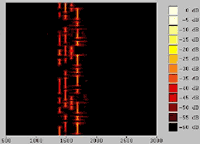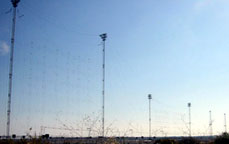Thursday 20 October, 2005, 09:07 - Radio Randomness
You often read about 'strange signals' being heard on various frequencies; there are lots of web-sites which provide listings of the frequencies on which these oddities can be heard. But I was surprised to discover that there are some weird goings on in the amateur bands. Not, that is, because they are in any way sacrosanct, but because these things often occur in the 'twighlight zone', i.e. those frequencies which don't seem to belong to anyone in particular because they sit between Fixed, Mobile, Amateur, Broadcasting and other allocations.My attention was drawn to 'Cluster Beacons': a series of CW (Morse) transmitters which are clustered very closely together in frequency and do nothing other than transmit the same letter over and over (and over) again. Such beacons have apparently been heard in the 40m amateur band occupying frequencies on or just below 7039 kHz. Now usually such things can only be heard by people with mile-long multi-element beam antennas and ultra sensitive receivers so I tuned my receiver to the frequency in question expecting to hear absolutely nothing (always the optimist). To my surprise, not only were these cluster beacons audible but (especially during the hours of darkness) they put quite a good signal into the UK. In particular the 'C', 'D', 'O' and 'S' beacons are audible for most of the day.
 Not much is officially written about what the purpose of such beacons might be, however the received consensus is that they are either for monitoring propagation or are for navigation (the spectrogram on the right shows a waterfall of one of the clusters in action). What is known is that they come from various cities in the Former Soviet Union; each city is represented by a unique letter. This is a list I found elsewhere, I have no idea how accurate or up to date it is:
Not much is officially written about what the purpose of such beacons might be, however the received consensus is that they are either for monitoring propagation or are for navigation (the spectrogram on the right shows a waterfall of one of the clusters in action). What is known is that they come from various cities in the Former Soviet Union; each city is represented by a unique letter. This is a list I found elsewhere, I have no idea how accurate or up to date it is:'A' Unid.
'B' Archangelsk
'C' Moscow
'D' Odessa
'F' Vladivostok
'K' Peteropavlovsk Kamchatskiy
'L' St. Petersburg
'M' Magadan
'O' Moscow
'P' Kaliningrad
'R' Izhevsk
'S' Arkhangelsk
'V' Khiva
As well as being clustered around 7039 kHz in the 40m amateur band, other cluster hot-spots are noted as being 5154, 7039, 8495, 10872, 13258, 16332 and 20048 kHz. I checked these and found that as well as those around 7039, beacons around 10872, 16332 and 20048 kHz were audible during the day (as of October 2005).
Whatever purpose these beacons officially serve, they are useful as a propagation check, if you happen to want to use HF to be communicating with Russia. Alternatively, if you can find a nice clear frequency where only the beacons are audible, the gentle tonal pulsating of the beacons is strangely hypnotic!
add comment
( 1468 views )
| permalink
| 



 ( 3.4 / 94 )
( 3.4 / 94 )




 ( 3.4 / 94 )
( 3.4 / 94 )
Wednesday 19 October, 2005, 08:19 - Amateur Radio
Listening to the 17 and 15 metre amateur bands recently, I was puzzled by a buzzing that occasionally appeared. Centred around 21300 and 18130 kHz, the odd 50 Hz buzz spread over about 30 kHz (which almost wipes out the whole SSB section of the 17 metre band, which is only 57 kHz wide in total!)A quick web-search and I discovered the IARU Region 1 Monitoring System (the IARU is the International Amateur Radio Union in case you were wondering) who monitor intruders in the amateur bands. To my surprise (I thought these things had died in the late 1980's) the signal is none other than an over-the-horizon (OTH) radar.
 But to make matters worse, this particular one emanates from Cyprus and is brought to us courtesy of the British Military base at Akrotiri (see the picture on the right) - my own side! - where there have recently been riots due to the installation of new antennas...
But to make matters worse, this particular one emanates from Cyprus and is brought to us courtesy of the British Military base at Akrotiri (see the picture on the right) - my own side! - where there have recently been riots due to the installation of new antennas...And it seems that Cyprus is not the only one. The Russian Woodpecker is still drilling holes in the amateur bands, and has been joined by Iran who have updated their OTH radar which can apparently be heard on 14000 and 21000 kHz from time to time. There are also some civil radars that occasionally splash against the amateur bands which use HF frequencies to monitor the state of the sea (cold, wet, salty... what more do you need to know?)
The real surprise in all this is that with modern day spy satellites and other surveillance mechanisms, it's amazing that such primitive technology is still useful. Apparently the radars are only used in times of heightened security risk but what with the atrocities of 9/11 in the US (and the UK's much smaller 7/11 bombings in London) I guess risk is high again. Shame. And shame on the British Military for causing all that nasty interference!
Postscript: I was (cough, ahem) checking the frequencies used by the RAF for 'Architect', their HF communication network and lo and behold up cropped the Cyprus radar centred on about 9040 kHz, so they are 'crapping in their own back yard' too!


